The Economics and Statistics Division maintains archives of previous publications for accountability purposes, but makes no updates to keep these documents current with the latest data revisions from Statistics Canada. As a result, information in older documents may not be accurate. Please exercise caution when referring to older documents. For the latest information and historical data, please contact the individual listed to the right.
<--- Return to Archive
For additional information relating to this article, please contact:
May 20, 2020ANALYSIS OF NOVA SCOTIA'S CONSUMER PRICE INDEX FOR APRIL 2020 TRENDS - April 2020
In Nova Scotia April 2020, the year over year the All-Items Consumer Price Index was 0.6 down per cent, the national CPI index declined 0.2 per cent. Monthly consumer prices were down 1.0 per cent in Nova Scotia and 0.7 per cent nationally. All provinces, except Quebec (+0.2%) and British Columbia (0.0%) had negative year-over-year inflation rate for April 2020. British Columbia had the highest inflation compared to April 2019 at 0.2 per cent while largest decline was in Newfoundland and Labrador (-1.5 %).
The national year-over-year CPI change decreased from a positive 0.9 per cent in March to -0.2 per cent in April. The year-over-year decline in CPI was first since September 2009 with the CPI declining from the fall in energy prices.
Nationally, gasoline prices were down 39.3 per cent - the largest year-over-year decline on record. Excluding energy prices, Canada CPI rose 1.6 per cent compared to April 2019. Clothing and footwear was down 5.9 per cent on monthly basis, the largest monthly decline for the component. In-person shopping for non-essential goods was restricted leaving retailers with high seasonal inventories that were largely discounted to be sold online. Food prices were higher in April as demand remained high. Year-over-year prices for rice, eggs, and margarine posted significant increases. Pork and beef prices rose on higher sales and supply issues as meat processing plants have cut production and closed amid the pandemic.
Nationally, Paper supplies index, which includes toilet paper, increased 6.0 per cent compared to March 2020 - the largest monthly increase in this index.
Traveller accommodation prices were down 9.8 per cent year-over year with their largest decline since 2011. Prices fell in all provinces and in areas around major tourist attractions (i.e. Niagara Falls).
Consumer electricity prices declined 4.1 per cent compared to April 2019 in Canada with Ontario prices falling 12.6 per cent due to provincial government's 45-day suspension of time-of-use rates.
Impact of COVID-19 on the Consumer Price Index
For the April 2020 CPI, in-person field collection was conducted via telephone or internet and supplemented with web scraping, transaction data, and administrative data. Due to COVID-19 impact on product availability, select sub-components of the CPI received temporary special imputations. The sub-indexes for housekeeping services; personal care services; travel tours; spectator entertainment and use of recreational facilities were imputed from the monthly change in the all-items index - effectively removing the impact of these goods and services on the CPI. Air transportation that was purchased but cancelled is excluded from calculations. Indexes for alcohol consumption in licensed establishments was imputed based on prices from stores.

Nova Scotia's consumer price inflation (year over year growth in CPI) excluding food and energy rose 1.5 per cent in April higher than the national rate of 1.5 per cent. Price level gains for this index were largest in Manitoba (+1.6 per cent), and lowest in Newfoundland and Labrador (+0.3 per cent). On a monthly basis, the index excluding food and energy was down for all provinces with a 0.5 per cent decline in Nova Scotia.
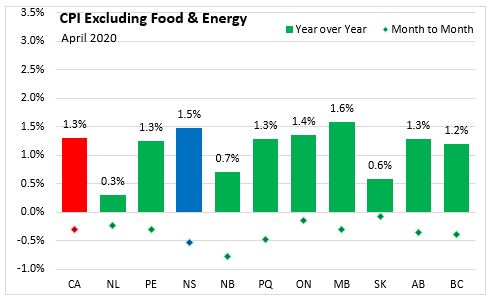
The main contributors to the monthly (April 2020 vs. March 2020) NS CPI movement were:
- Dairy products (+6.0%)
- Other food preparations (NA)
- Paper, plastic and aluminum foil supplies (+6.7%)
- Gasoline (-20.3%)
- Fuel oil and other fuels (-13.1%)
- Women's clothing (-10.2%)
Contributors to the annual (April 2020 vs. April 2019) NS CPI movement were:
- Passenger vehicle insurance premiums (+9.2%)
- Rent (+3.5%)
- Food purchased from restaurants (+3.1%)
- Gasoline (-46.5%)
- Fuel oil and other fuels (-22.1%)
- telephone service (-5.6%)
The CPI for food in Nova Scotia increased 5.3 per cent year-over-year with a 1.3 per cent increase month-to-month. CPI growth in food (year over year) was up in all provinces compared to April 2019. Prince Edward Island posted the highest year over year food price growth (+6.6 per cent). Nationally, annual food prices increased 3.4 per cent.
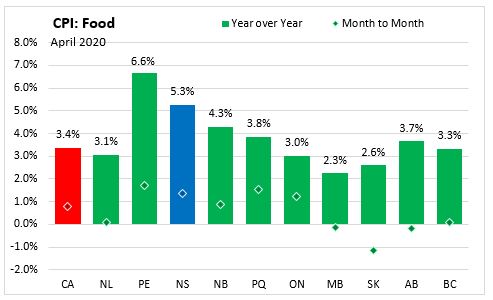
The Nova Scotia energy price index decreased by 25.7 per cent compared to a year ago. Monthly energy prices (April 2020 vs. March 2020) were down 10.7 per cent in Nova Scotia and 8.7 per cent nationally. Year-over-year energy price indexes decreased in every province with the largest decrease in Prince Edward Island (-28.5 per cent).
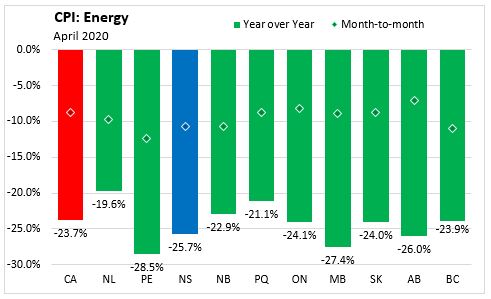
Year over year, the consumer price index for shelter increased by 2.1 per cent in Nova Scotia and 1.6 per cent in Canada. Shelter costs were up in every province.

Major Components for March 2020
The following table shows the price increases specific to Nova Scotia for the major components of the CPI this month:
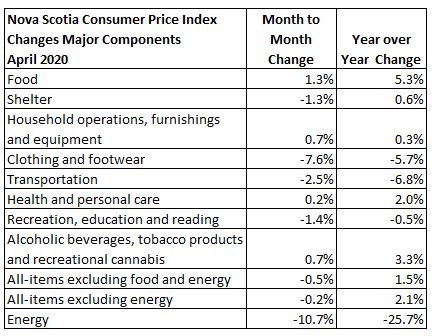
Long Run Trends
In April 2020, the All-Items CPI year over year inflation rate for Nova Scotia was 0.6 per cent, below Canada's at -0.2 per cent. Nova Scotia's annual inflation has mostly been below the Canadian average since mid-2014, with the exception of only a few months. While month to month movements in the indices can be different, over time they generally follow the same overall trend.
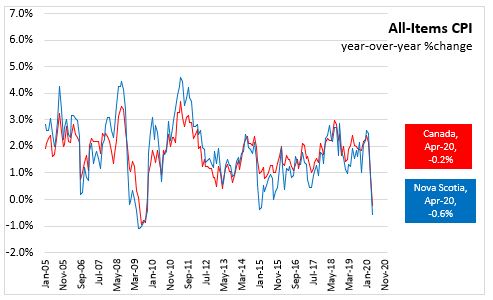
Annual inflation for the CPI excluding food and energy in Nova Scotia (1.5 per cent) was higher than the national rate (1.3 per cent) in April 2020.
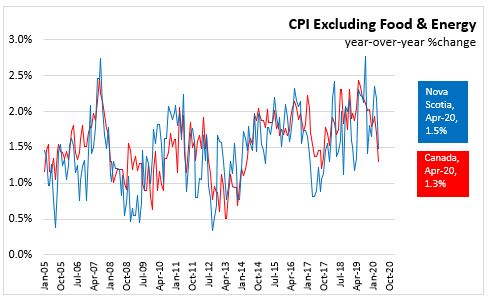
Bank of Canada's preferred measures of core inflation
Compared with April 2019, CPI-Common increased 1.6 per cent, CPI-Median rose 2.0 per cent and CPI-Trim was up 1.8 per cent in Canada. All-items CPI excluding eight of the most volatile components as defined by the Bank of Canada, and excluding the effect of changes in indirect taxes (formerly referred to as CPIX), rose 1.2 per cent year over year.

Appendix Tables and Charts
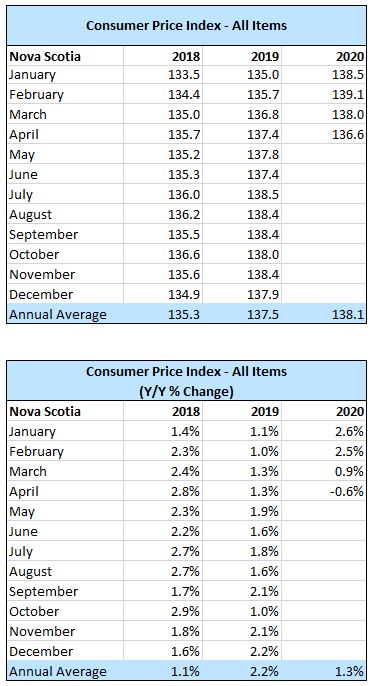
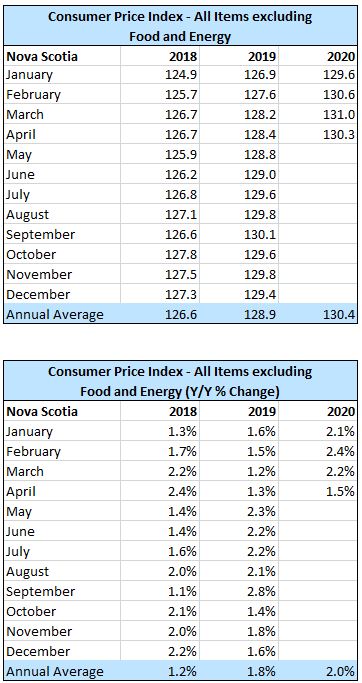
Source: Statistics Canada data portal: Tables 18-10-0004-01 and 18-10-0256-01
<--- Return to Archive